7 Ways to Improve the SEO for Restaurant or Bar Websites
If you own a brick-and-mortar business, like a bar or restaurant, you need SEO to be found by potential customers in your area. When people search for a service or product, they often turn to search engines like Google to find options nearby. SEO can help you ensure that your bar or restaurant shows up in these searches and is visible to potential visitors.
Search engines like Google have also become more advanced in understanding users’ location and search preferences, and they use this information to adjust search results accordingly. For example, if someone located in Chicago searches for “pizza”, Google will prioritize showing local pizza places over pizza places in other cities or countries.
If your brick-and-mortar business lacks a strong online presence, optimizing it for local SEO is a great place to start. Follow this detailed guide to improve your bar or restaurant’s visibility and attract more local customers.
What is SEO for restaurants
The key difference between restaurant SEO and SEO in general is the level of geographic specificity and niche focus. While SEO aims to improve a website’s visibility and attract a broader audience, SEO for bars and restaurants is aimed at optimizing a website for local search results in a food niche.
It also involves distinct SEO techniques, such as local citations, business listings, and customer reviews. This is in addition to general SEO practices like keyword research, on-page optimization, and backlink building. For example, you can create pages on your website that target specific local keywords, such as “best pizza place in Chicago”, and optimize those pages with relevant content and meta tags.
You can also claim and optimize your Google Business listing. This improves your chances of appearing in the local pack — a special block at the top of Google search results.
Why restaurants need SEO
SEO is crucial for bars and restaurants because it’s easy to fall behind the countless other bar and restaurant sites on the internet. Your top-notch services must be backed by technical prowess to attract new customers in the highly competitive food and drink industry. By optimizing your website and content for local search terms, your business can rank higher in search results when potential customers search for relevant keywords in your area. This can lead to increased website traffic, bookings, and orders, ultimately leading to higher revenue.

Restaurant SEO techniques, such as managing local listings and creating location-specific content, can also help businesses build credibility and trust with local customers. This will improve your overall online reputation over time. Additionally, investing in SEO can give your business a significant competitive advantage over your competitors because it will be more likely to appear in local search results. In general, applying SEO techniques can provide substantial benefits to your bar or restaurant, especially if the competition is getting fiercer in your area and you can’t afford not to enhance the site’s online presence to attract more local customers.
How to build an SEO strategy for your bar or restaurant
Before putting together a local SEO strategy for your bar or restaurant, there are several important factors to consider: each can guide your approach and help you target the right audience with the right message.
Here are some of the most important factors:
- Set clear goals: Determine specific objectives that align with your business’s objectives, such as increasing website traffic, improving brand awareness, or driving more foot traffic to your place.
- Analyze your Unique Value Proposition: Evaluate your menu, services, target audience, and what sets you apart from your competing bars or restaurants.
- Analyze competitors: Study your competitors’ online presence to identify opportunities for differentiation and improvement in your local market. This includes examining their website content, social media activity, and online reviews.
- Analyze niches: Understand the specific niches or subcategories within your local food and beverages market so that you can tailor your SEO strategy to the needs of your customers.
- Assess local search trends: Analyze local search volume and patterns to understand when and how local customers search for bars and restaurants.
- Conduct keyword research: Use tools like Google Keyword Planner and SE Ranking to identify the most relevant and high-traffic search terms.
- Create a content strategy: Establish your business as an authority in your local food market and attract more local customers by creating social media posts, videos, and other types of content targeted specifically at your potential clients.
- Monitor and measure results: Track your website traffic, search rankings, and other key metrics using tools like Google Analytics, Google Search Console, and SE Ranking to evaluate the effectiveness of your SEO strategy over time.
By considering these factors when developing an SEO strategy that aligns best with your business’s objectives, you can improve your online visibility, attract more local customers, and achieve long-term success in your market.
Let’s now move on and explore some key steps to take when implementing your SEO strategy.
1. Research the websites of competing bars and restaurants
Conducting competitive research can help you identify gaps and opportunities in the local market, gain insights into what is working (and what isn’t) for your competitors, and adjust your SEO strategy accordingly.
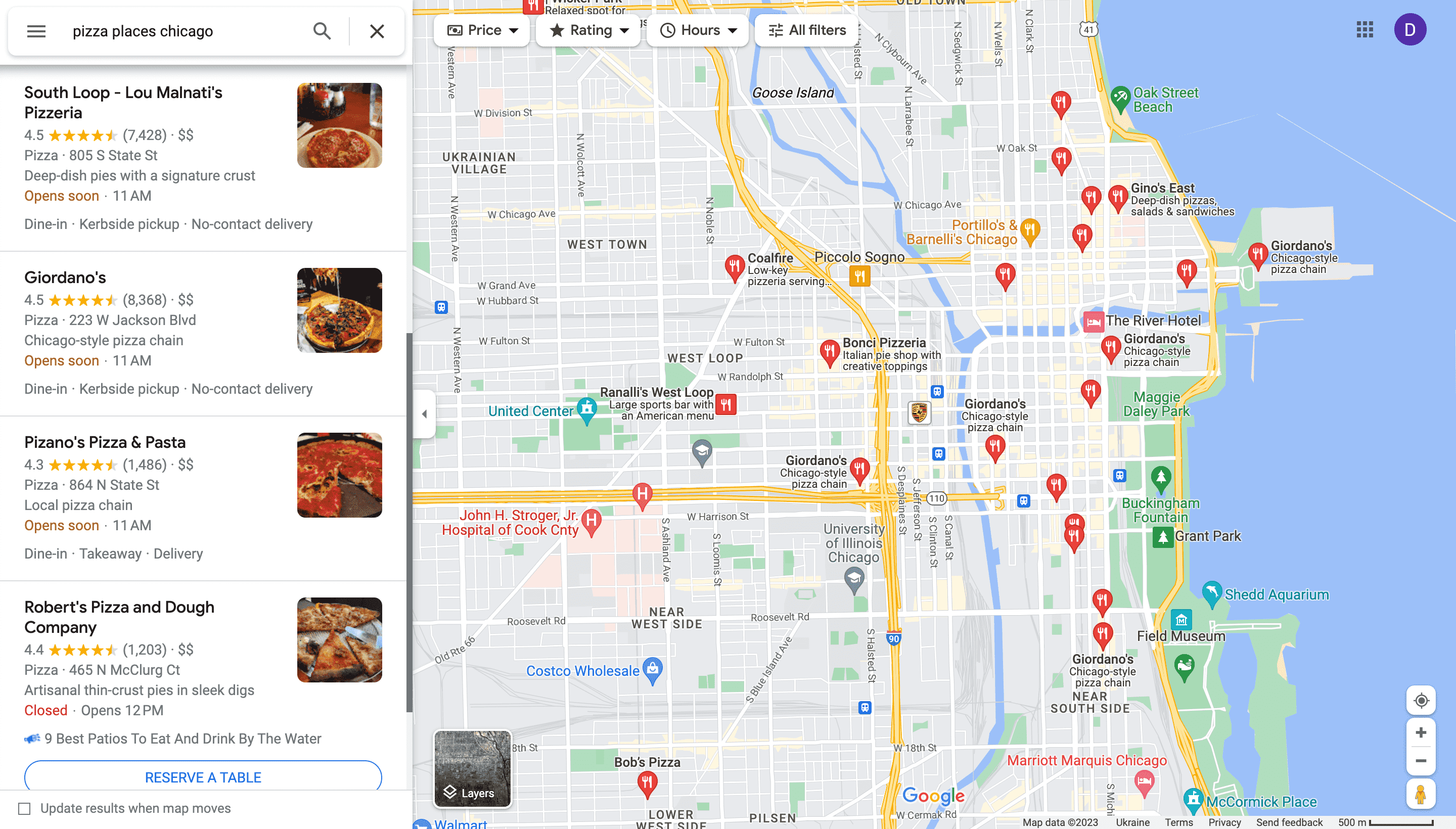
By analyzing your competitors’ websites, local listings, social media activity, online reviews, and backlinks, you can differentiate yourself from your competitors and attract more local customers to your business. Let’s look at how to do this in more detail:
- Analyze their website: Look at the design, layout, and structure of their website to identify what is working well and what can be improved. Pay attention to the content on their pages, including the use of keywords, images, and videos.
- Check their local listings: Check the local listings of your competitors, including their Google Business profiles, Yelp pages and other online directories. This will give you a sense of how they are positioning themselves in the local market and how customers are responding to their listings.
- Analyze their online reviews: Analyze your competitors’ online reviews to identify areas where they are excelling or falling short. This can help you identify the best areas to differentiate yourself and provide a better experience for your customers.
- Pay attention to backlinks: Look at your competitors’ backlinks to identify any websites linking to their pages. This can give you ideas for potential link-building opportunities and help you understand how your competitors are building their online authority.
- Identify gaps and opportunities: Based on your analysis of your competitors, identify opportunities in the local market that you can take advantage of. This might include targeting specific keywords, creating content that addresses customer cravings, or improving the overall user experience on your website and local listings.
SE Ranking is a powerful tool that can assist with conducting competitive research for local SEO in the bars and restaurants industry. Using its Competitor Analysis Tool, SE Ranking enables you to analyze your competitors’ websites, identify their top keywords and pages, as well as other data on organic and paid search. By using SE Ranking, you can gain valuable insights into your competitors’ online presence and develop a more effective SEO strategy for your bar or restaurant.
By conducting a thorough analysis of your competitors, you can gain valuable insights into what is working in your local market and adjust your SEO strategy accordingly. This can help you find new ways to differentiate yourself from your competitors and attract more local customers to your business.
2. Collect keywords and add location markers
Having the right set of keywords is crucial for SEO, as it helps potential customers find your bar or restaurant online. Here are some steps to follow when selecting and integrating keywords with location pointers:
- Define the head term: Select the primary keyword that represents your bar or restaurant and specify your business’s type with a term like, “sports bar” or “italian restaurant”. This will be your head term.
- Aggregate your semantic core: Look up similar, related, and long-tail keywords that people use to find a bar or restaurant, such as “take out italian restaurants” or “sports bar and grill”. These keywords form the basis of your semantic core. Refer to this list when adding a new set of keywords and remove any queries that don’t relate to your business.
- Add location markers: Including location identifiers in keywords like city names, boroughs, or districts, can help search engines understand the geographical relevance of your business and improve your chances of appearing in local search results. Location markers like “near me” or “nearby” can also increase the visibility of your website for users searching for businesses in their area.
- Analyze search intent: User search intent analysis is critical for optimizing your content to meet the needs of your target audience. This is because it helps you understand the intent behind the keywords people use to search for local bars and restaurants. For example, when users search for “best italian restaurants chicago”, they expect to see a list of top-rated Italian restaurants in Chicago, not your landing page.
Some examples of high-performing keywords for a bar or a restaurant:
- “breakfast/lunch/dinner/drinks” + “near me/nearby” OR [City]
- “type of cuisine” + “near me/nearby” OR [City]
- “particular dish” + “near me/nearby” OR [City]
- “restaurant’s name” + “near me/nearby” OR [City] (if you belong to a chain or a franchise).

SE Ranking’s Keyword Suggestion Tool is a powerful solution for finding related keywords and grouping them for easy management. With this tool, you can quickly discover new keyword ideas and analyze their search volume, competition, and relevance to your business. You can also organize your keywords and track their performance over time, making it easier to optimize your content for maximum search engine visibility.
3. Make your site visible in local business directories
When searching for local bars or restaurants on Google, the search engine usually returns a SERP that includes a Local Pack. This section is highly coveted, as it displays the top three local businesses related to the user’s search query.
By appearing in the Local Pack, bars and restaurants have the opportunity to receive more clicks and phone calls than those that appear further down the search results page. It’s also true that being listed in the Local Pack helps to build trust and credibility with potential customers, as they can easily see the ratings, reviews, and location of the business.
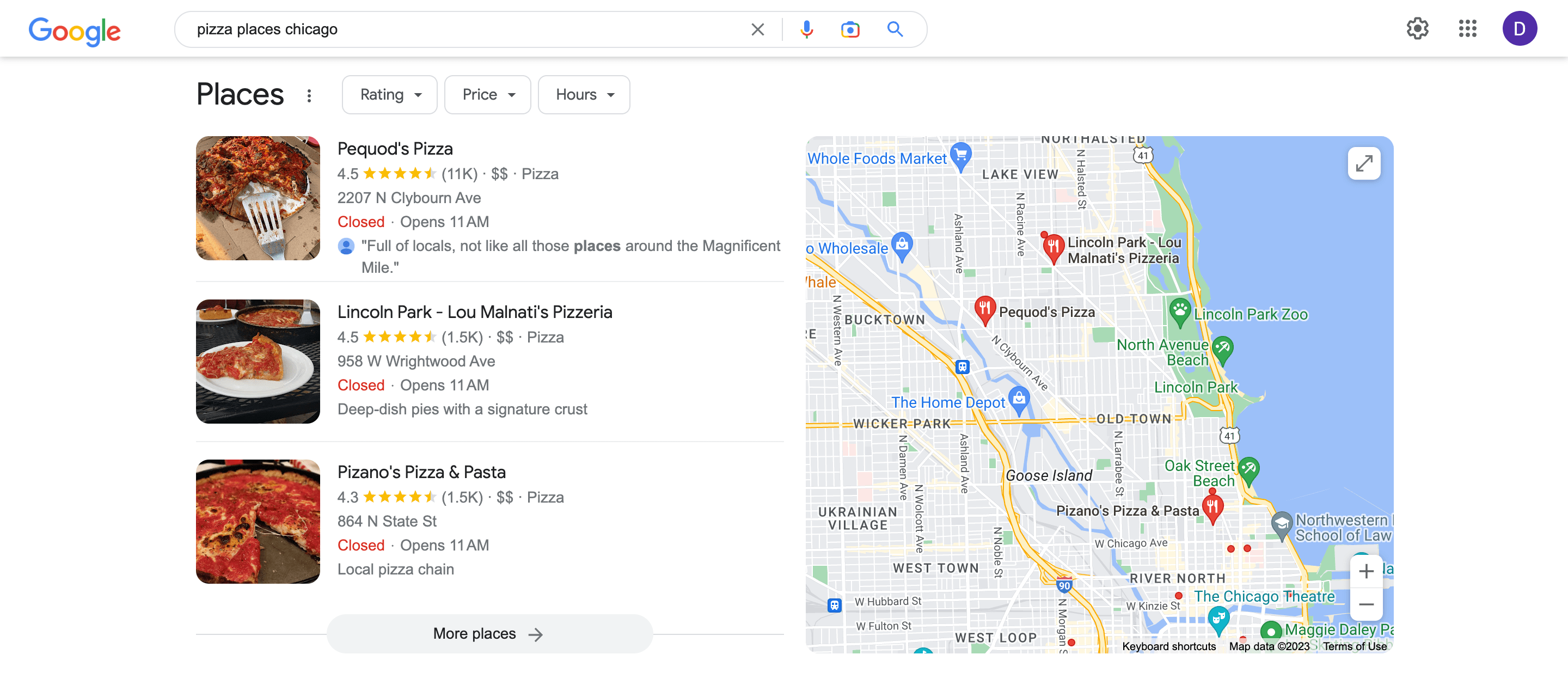
Bing provides a similar service to Google called Bing Places for Business. By appearing in Bing’s local results, your bar can gain more clicks or phone calls than your local competitors. Bing Places for Business also allows brick and mortar businesses like yours to manage their online presence, provide accurate contact information, and showcase products and services.
Optimizing your Bing Places for Business profile can improve your business’s overall online visibility and increase its likelihood of appearing in local search results. To get started, claim and verify your Bing Places for Business profile.
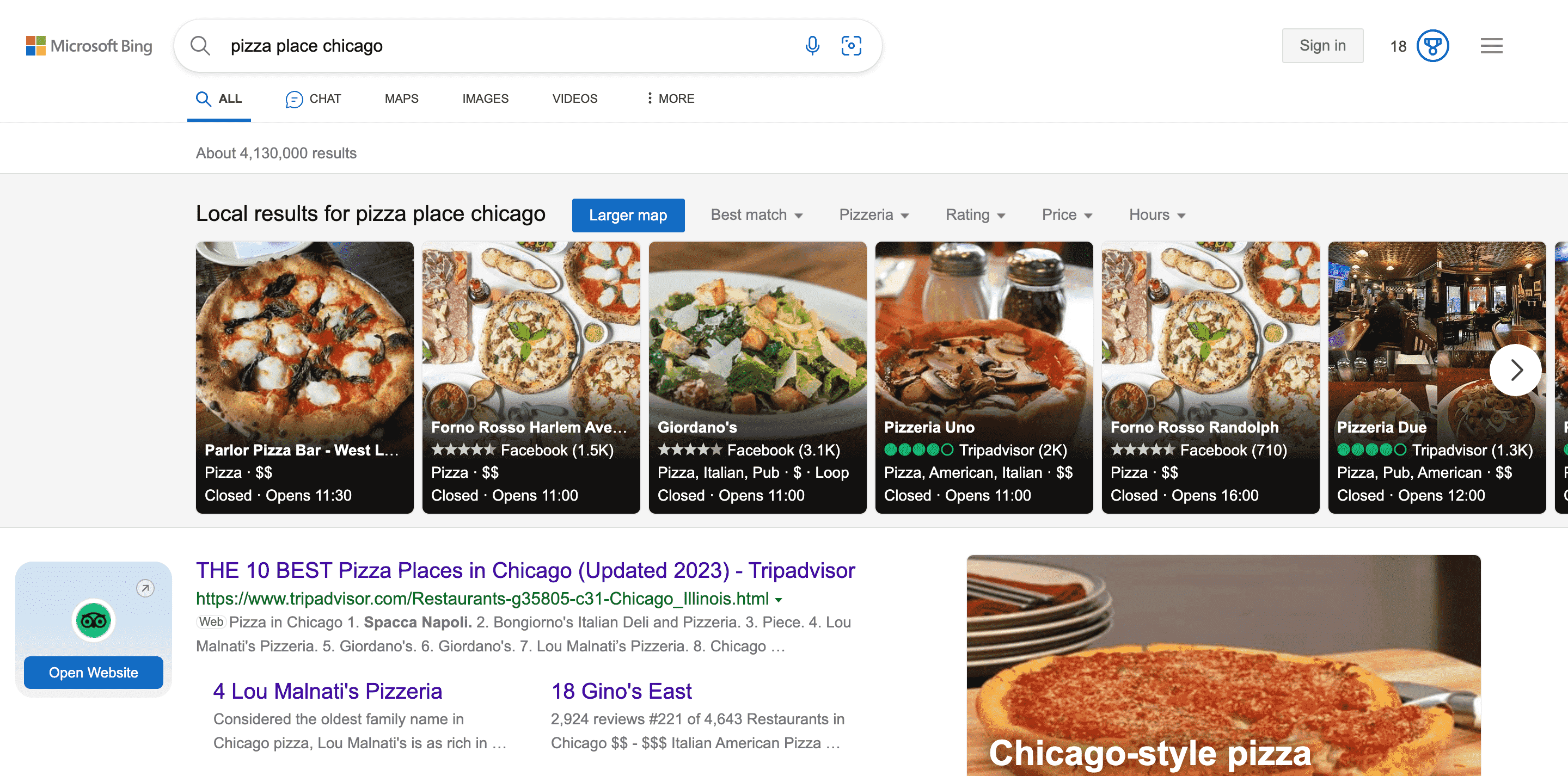
To increase your chances of appearing in both the Google Local Pack and Bing Places, here are some tips to follow:
- Claim and verify your business listing: Start by creating a Google Business and Bing account, and provide information about your business. Make sure to choose only one category that best describes your business. After that, verify your business to confirm your ownership.
- Add essential business information: Once you have claimed your business listing, optimize it by adding detailed information such as your business hours, address, phone number, website URL, and high-quality photos.
- Double check your NAP data: Make sure that the NAP information (Name, Address, & Phone number) you’ve provided in your account is an exact match with the data on your website.
- Optimize your business listing: Google and Bing allow restaurants and bars to create and edit their menu, showcase their best dishes, and provide information about their services such as dine-in, takeout, or delivery. You can also include health and safety measures in your business profile. Additionally, you can connect Google services to enable your customers to make reservations, order takeout, or delivery directly from the SERP.
- Regularly update your business information: It’s essential to keep your business information up-to-date on online directories. This ensures that your customers have the latest and most accurate information about your business. Update your business hours, phone number, address, and other details regularly, especially if there are changes to your business operations.
SE Ranking’s Local Marketing tool is a powerful platform that helps businesses manage their online presence across multiple locations. It features a dedicated Google Business Profile Audit, allowing businesses to easily manage their business listings and ensure that their information is accurate and up-to-date. With this tool, you can find out where your business appears on Google, evaluate the accuracy of your business’s information across local listings, and gain insights on your customers’ reviews. This data can help you improve your online visibility and make better decisions regarding your SEO and marketing strategies.
4. Make your website mobile-friendly
People typically search for bars and restaurants on the go, so it can’t be understated how important it is for your site to have a fast and fully functional mobile website version. Mobile-friendly websites are crucial for SEO because Google prioritizes mobile-first indexing, meaning that mobile-friendly websites are more likely to rank higher in search results. So, choose an option that is not only user-friendly but also optimized for SEO.
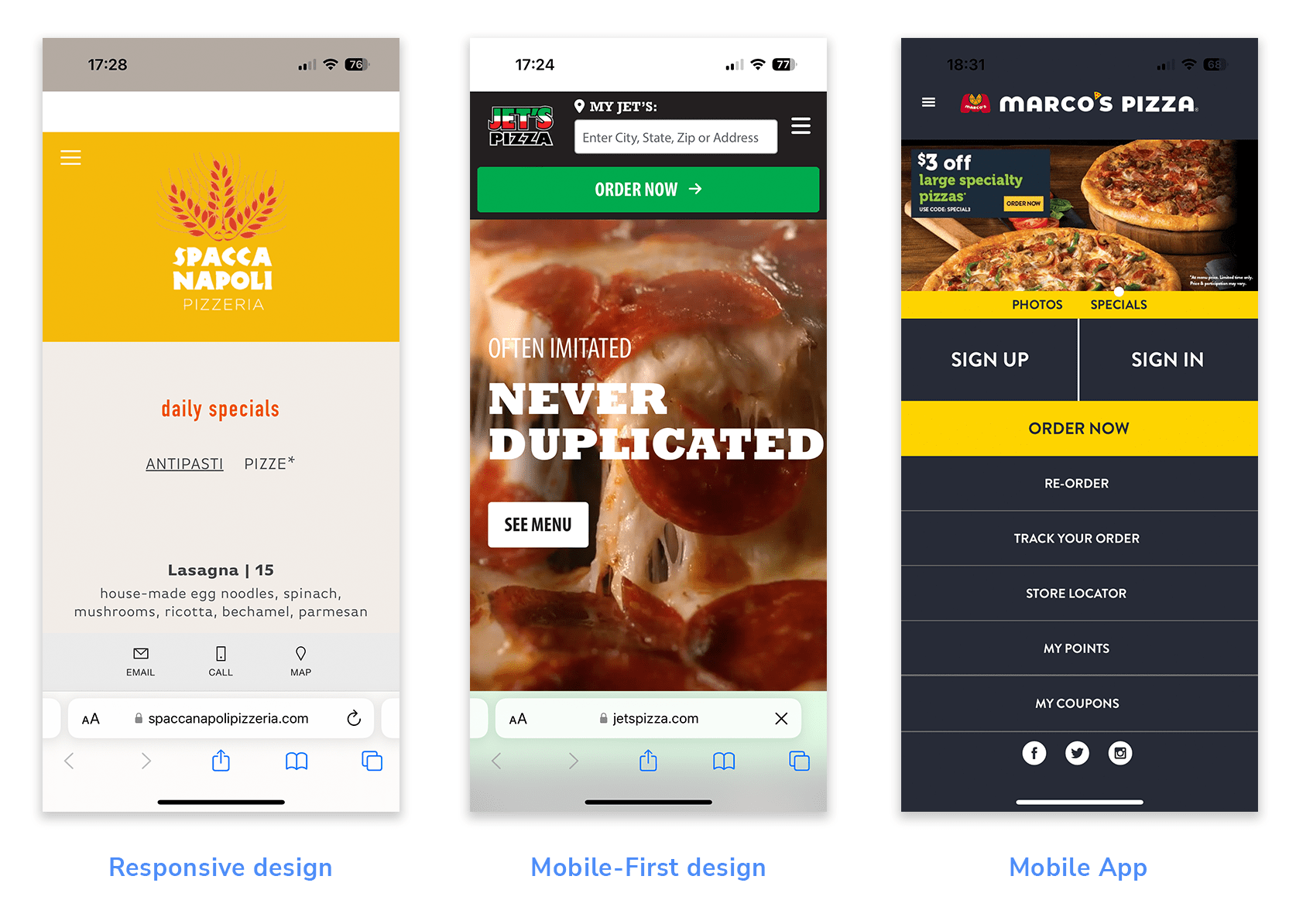
To make a website mobile-friendly, there are three basic options to choose from:
- Responsive design: This approach involves making the existing website mobile-friendly without creating a separate mobile version. The website has the same URL and content as the desktop version, but it is resized for mobile screens. While it is relatively simple to develop, it can be slower and less convenient for users compared to a dedicated mobile website or app.
- Mobile-first design: This type of design is primarily focused on mobile devices and is optimized for smaller screens, touch controls, and slower internet speeds. It prioritizes mobile users’ needs, and the design and functionality are adapted to smaller screens, ensuring that the site loads quickly and is easy to use on a mobile device. Unlike responsive web design, mobile-first design requires a ground-up approach to ensure a seamless and effective mobile experience.
- Mobile app: Creating a mobile app for your business can provide a unique experience for users and provide features that are not available on a mobile website or responsive design. While it is the most challenging option to develop, it can offer tremendous benefits.
When choosing an option to make your website mobile-friendly, consider the functionality of your site. If you only intend to use your site to give users simple information such as contacts, the order menu, events, then a responsive design could be enough. But if you want users to make orders online or book a table using their smartphone, consider developing a mobile-first site or an app dedicated to your services.
Regularly monitoring the performance of your website’s ordering system is crucial. Doing this helps to ensure that customers have a smooth and seamless experience when placing orders, leading to increased customer satisfaction and repeat business. Regularly testing the ordering system can also help businesses identify and fix any technical issues that may arise, ensuring that orders are processed correctly and on time.
Once you have a mobile-friendly site, it is important to start tracking your search positions. Monitoring the search rankings of your site on the mobile SERP is key because they can differ dramatically from desktop results. Our Search Engine Rank Checker monitors both organic desktop and mobile search results, helping you stay on top of your website’s performance on both platforms.
5. Structure the information on your website
To attract potential customers to your restaurant, its main information should be easily accessible from the first page of search results. This includes not only the local pack result but also knowledge graphs for brand queries.
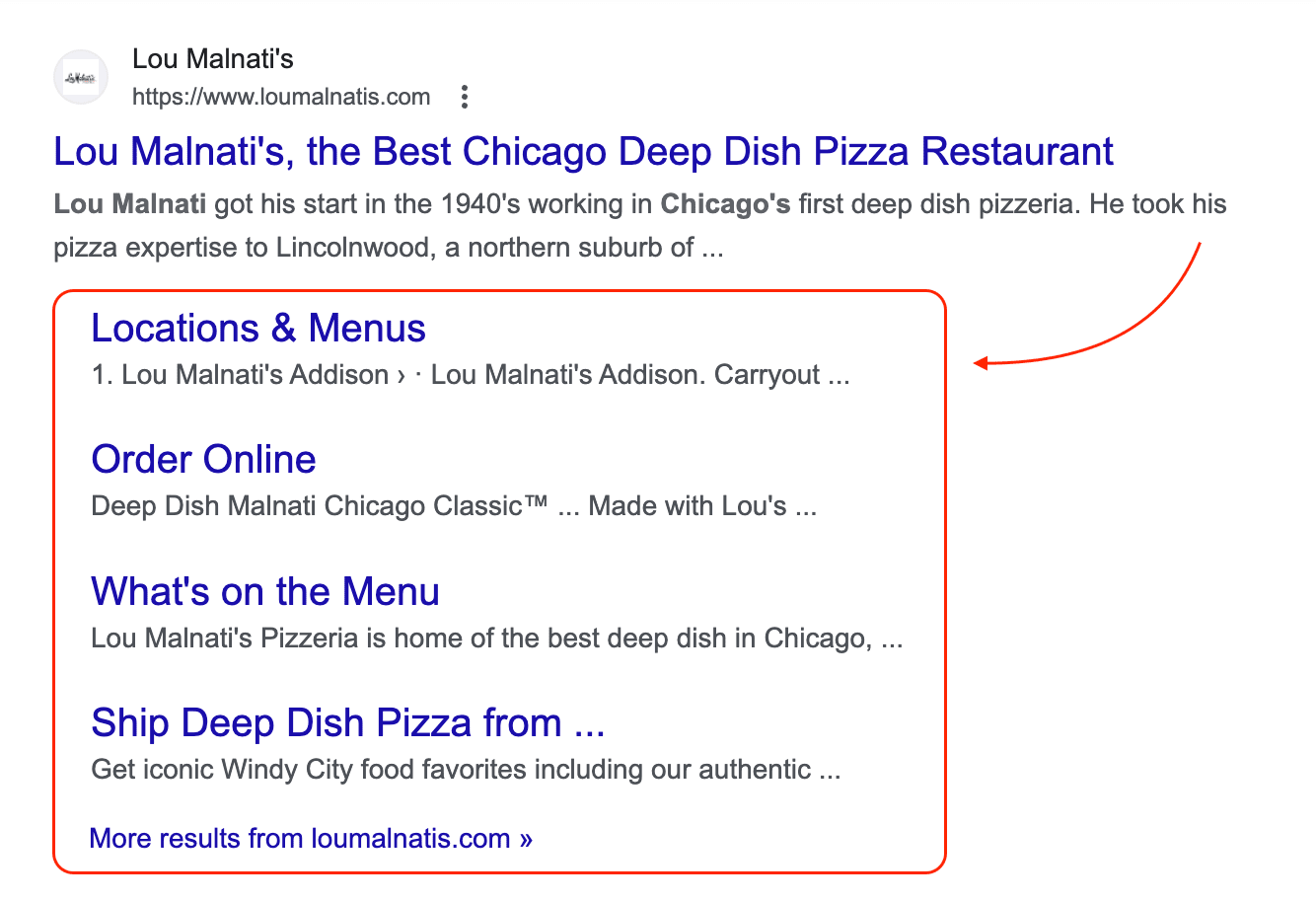
To help your restaurant stand out on the SERP, use Schema markup. This semantic vocabulary is a piece of code that can be added to a page to help search engines understand its content better. By structuring your information using Schema, you can highlight important details like your menu, which can be displayed directly on the first SERP. You’ll want to check out the Schema tags for restaurants, but before implementing markup, it’s important to ensure that your titles and meta descriptions are optimized.
Optimizing on-page elements such as titles, descriptions, headings, and body text is essential for SEO as they are displayed prominently on the SERP and can influence click-through rates. On-page optimization also entails ensuring that your website is mobile-friendly and has a fast loading speed, as these factors can impact user experience and search engine rankings. By implementing on-page SEO best practices, you can increase your restaurant’s chances of appearing at the top of search engine results pages for relevant queries, making it easier for potential customers to find you online.
SE Ranking’s SERP Analyzer is a powerful tool that provides a detailed analysis of the top search results for your target keywords. This tool enables you to easily check and analyze your competitors’ titles and descriptions as well as headings and other elements for better search engine visibility. By staying ahead of the competition and improving your website’s performance, you can boost your online presence.
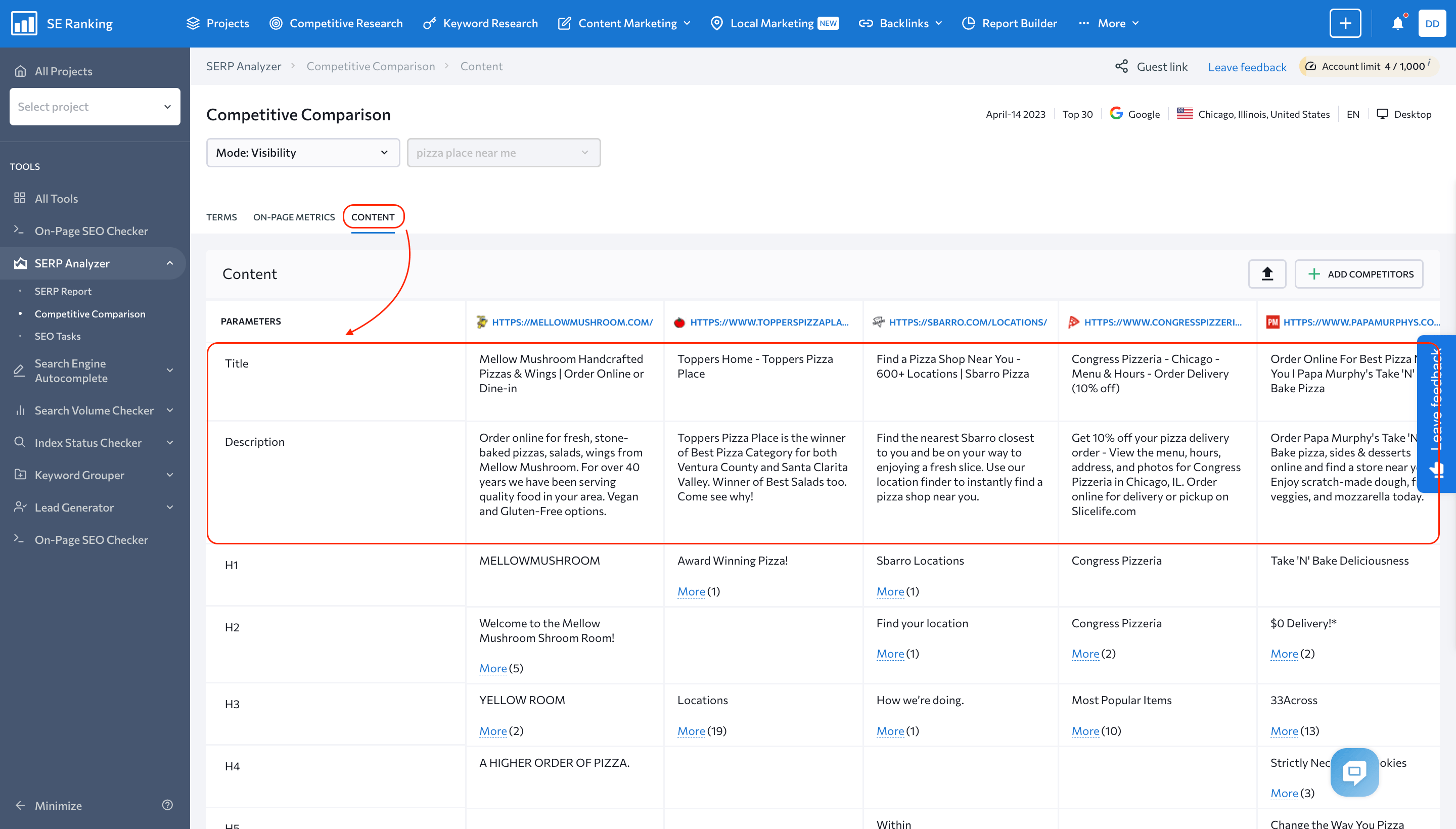
The navigation on a page should be clear and straightforward, with the menu and footer prominently displayed on every page. The main pages, including the menu, location, and contact page, should also be easy to access from the homepage.
In some cases, adding a blog section to a bar or restaurant’s website can be beneficial. This can help establish the brand as an authority in the industry and provide valuable information for customers. Still, you must ensure that the blog section is well-organized and easy to navigate, with categories and tags to help visitors find relevant content quickly.
Optimizing images is another important aspect of on-page SEO, particularly for bar and restaurant websites, as they often use a lot of photos to showcase their menus. Large image files can slow down page load times, resulting in a poor user experience and potentially lower search rankings.
To optimize images, make sure they are compressed and reduced in size without sacrificing their quality. Additionally, adding alt text to your images provides context and enhances accessibility for visually impaired users.
6. Get listed on review platforms and relevant food websites
Having your restaurant or bar listed on review platforms benefits your local SEO in two major ways. Firstly, positive reviews on these platforms can be displayed on Google Maps and in the SERP, making your business more attractive to potential customers. To make the most of these reviews, it’s important to read and respond to all feedback, working to turn negative reviews into positive ones. It’s also true that being listed on these platforms can help you build a healthy backlink profile.
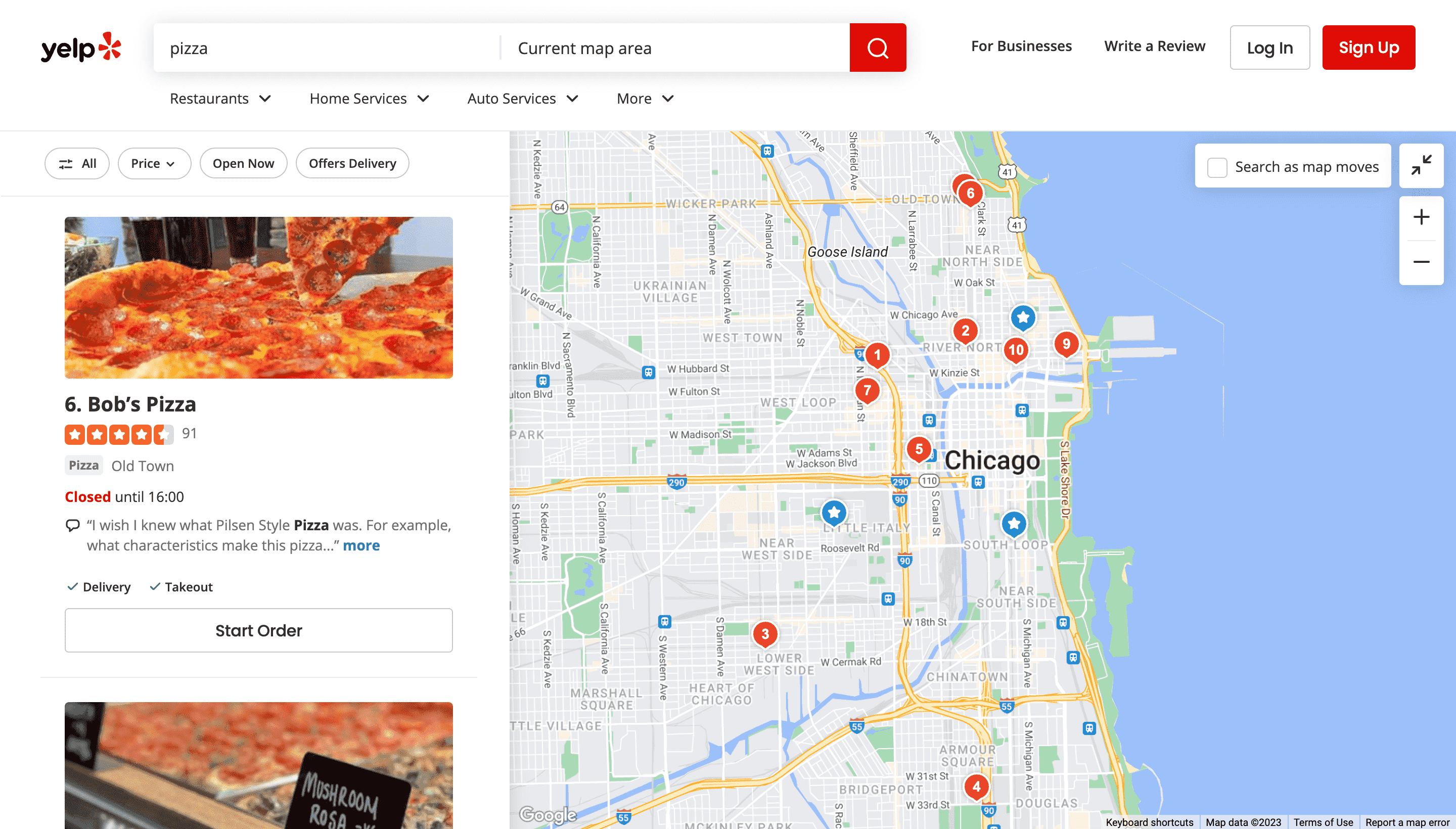
Here’s a list of potential sources:
- Review aggregators: Websites such as Tripadvisor, Yelp, and Foursquare can be especially beneficial for bars and restaurants. These platforms not only help you attract targeted traffic, but they can also help enhance your backlink profile.
- Thematically relevant websites and blogs: By getting backlinks from gastro or travel blogs, this not only improves your backlink profile but also attracts more local customers to your venue.
Building a strong backlink profile is a no-brainer for SEO success, and having profiles on popular review platforms and business listings can help enhance your backlinks while attracting more customers to your business. By combining the process of acquiring links from local and thematically relevant sources with leveraging social media platforms, you can establish a strong online presence and improve your visibility in local search results. See this complete list of popular business listings by country.
The next important thing to consider is customer reviews.
7. Manage your online reputation
Online reputation management is crucial for local businesses like bars and restaurants, as potential customers often turn to online reviews to make purchasing decisions. This involves monitoring and handling how a business is perceived by its customers and prospects on the internet.
Reputation management involves analyzing online reviews, social media mentions, and other forms of user-generated content to ensure that the business holds a positive reputation online. Analyzing these reviews can provide valuable insights into customers’ preferences, likes, and dislikes, allowing you to make improvements to your business’s offerings, services, and overall customer experience.
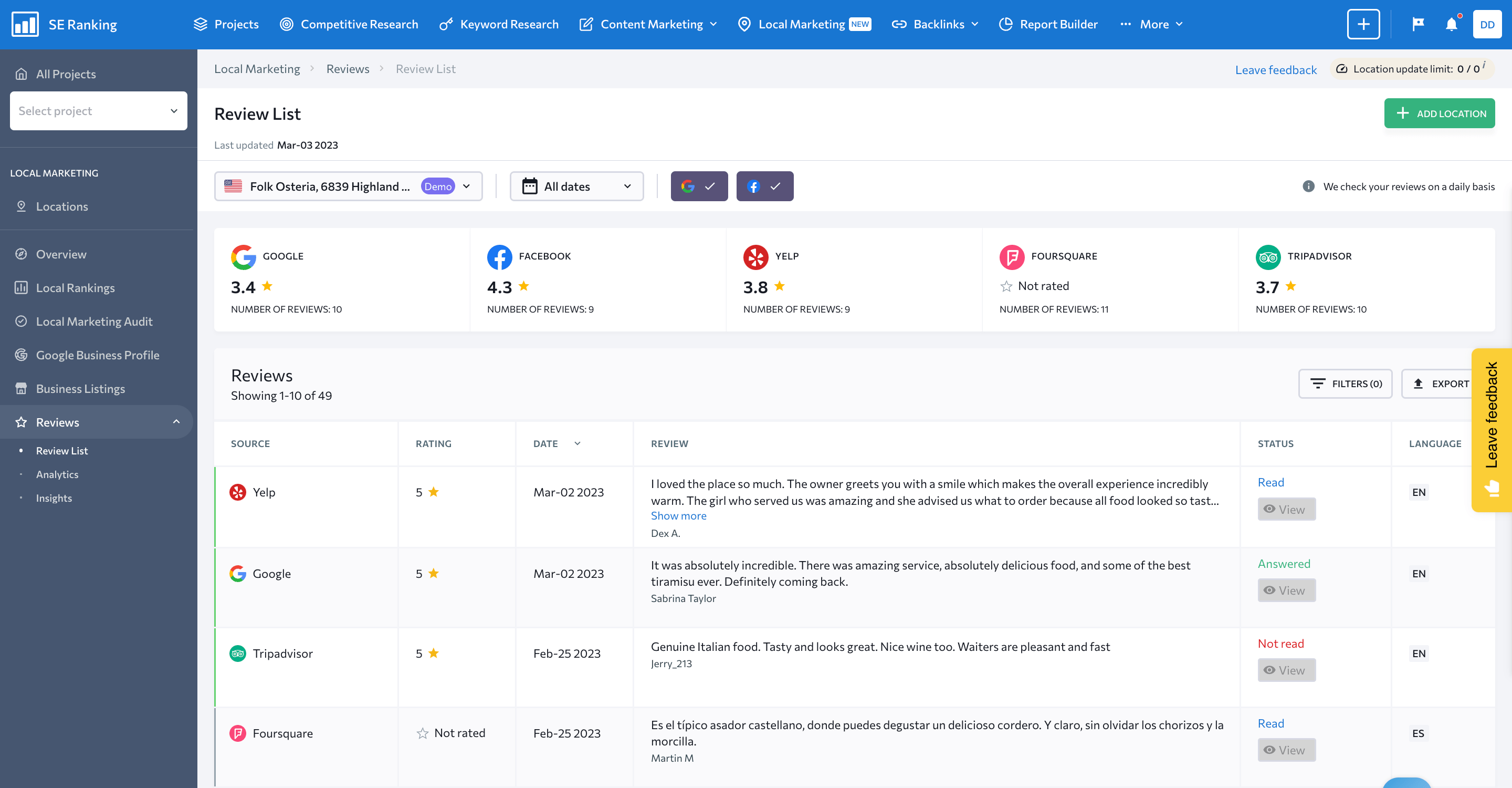
Summary
As a bar or restaurant owner, implementing SEO strategies can enhance your online visibility and attract more customers. To recap, here are the seven most decisive elements to focus on when launching an effective SEO campaign:
- Know the market: Start your campaign by thoroughly researching the competitive landscape: examine competitors, track market trends, and analyze the audience.
- Incorporate location markers into your keyword list: Consider the location of your bar or restaurant and use location-specific keywords in your website content and metadata. This assists in improving your search engine ranking for local queries.
- Create and optimize a Google Business Profile: This will ensure that your business appears on Google Maps and in local search results. Make sure your profile is complete with accurate contact information, business hours, and photos.
- Prioritize mobile optimization: With 78% of local searches on mobile resulting in an offline purchase, it’s essential to have a mobile-friendly website. Make sure your website is optimized for mobile devices and loads quickly.
- Use Schema: Incorporating Schema markup on your website can make your search snippets more informative and engaging. This can help improve your click-through rate and drive more traffic to your website.
- Establish profiles on review services: Create profiles on popular review sites such as Yelp, TripAdvisor, and Foursquare. Encourage your customers to leave positive reviews, as this can help boost your search engine ranking and attract more customers.
- Track your online reputation: Managing your online reputation and handling comments online is also an important aspect of local SEO for bars and restaurants. Online reviews and comments can have a significant impact on your business, as 98% of people read online reviews when doing research on local businesses.
Remember, restaurant SEO can be a highly effective tool in attracting new customers to your bar or restaurant. By following these tips and using effective SEO strategies, you can increase your online visibility and entice more customers to visit your business.

